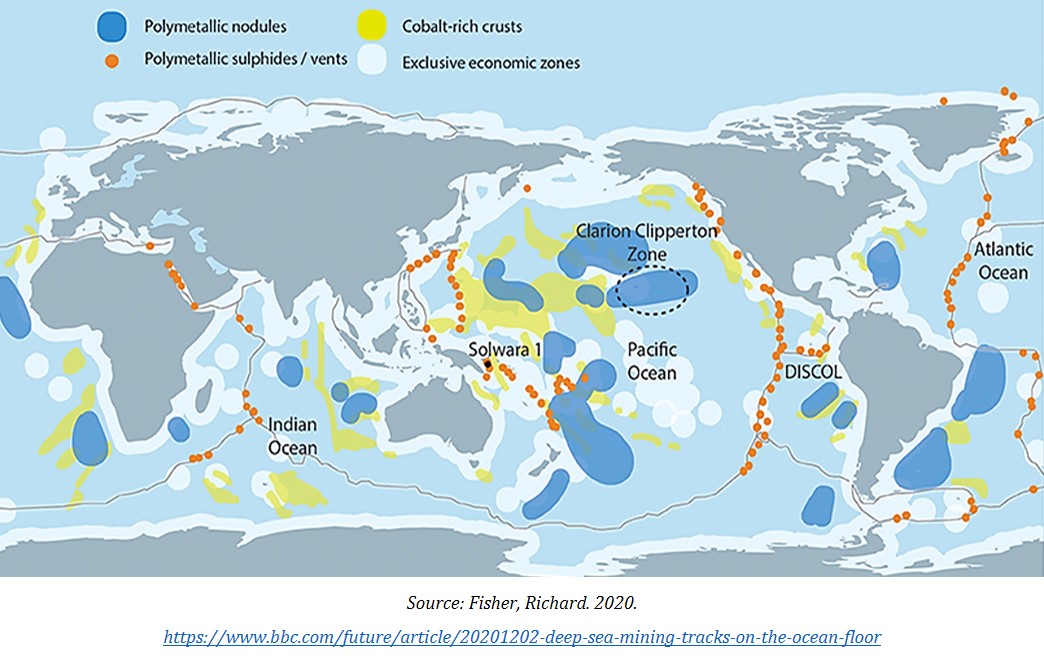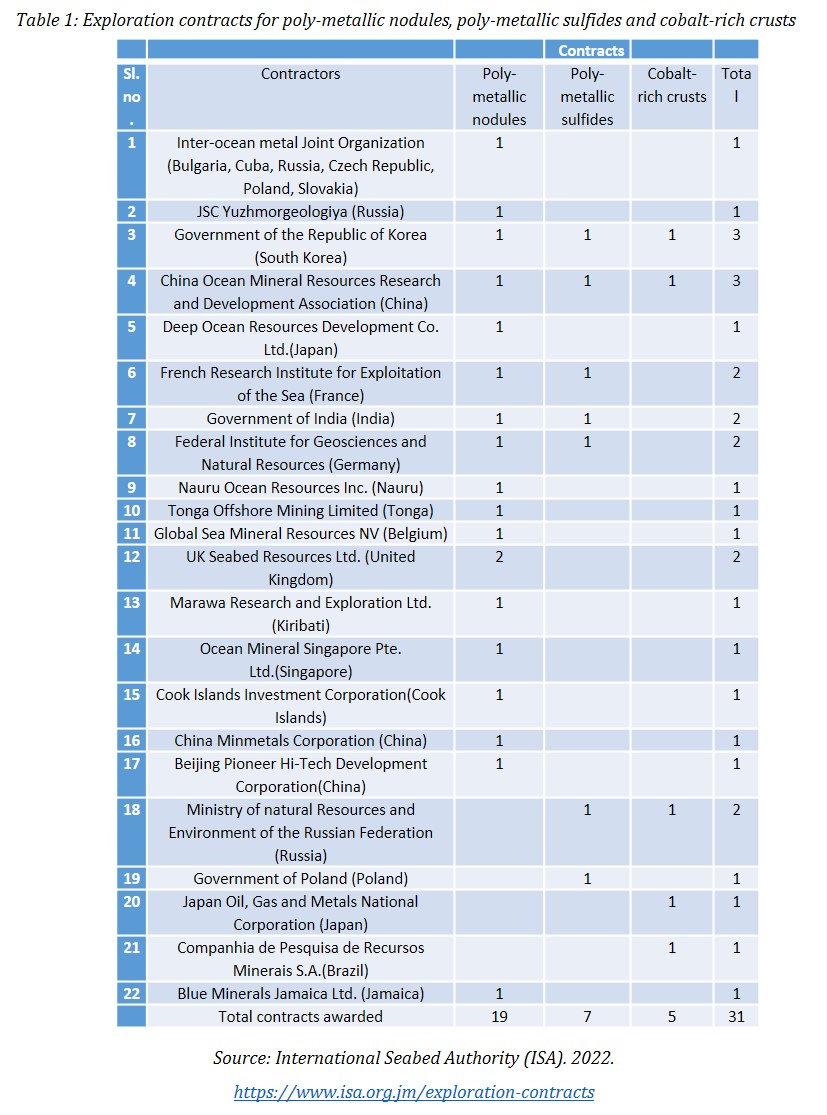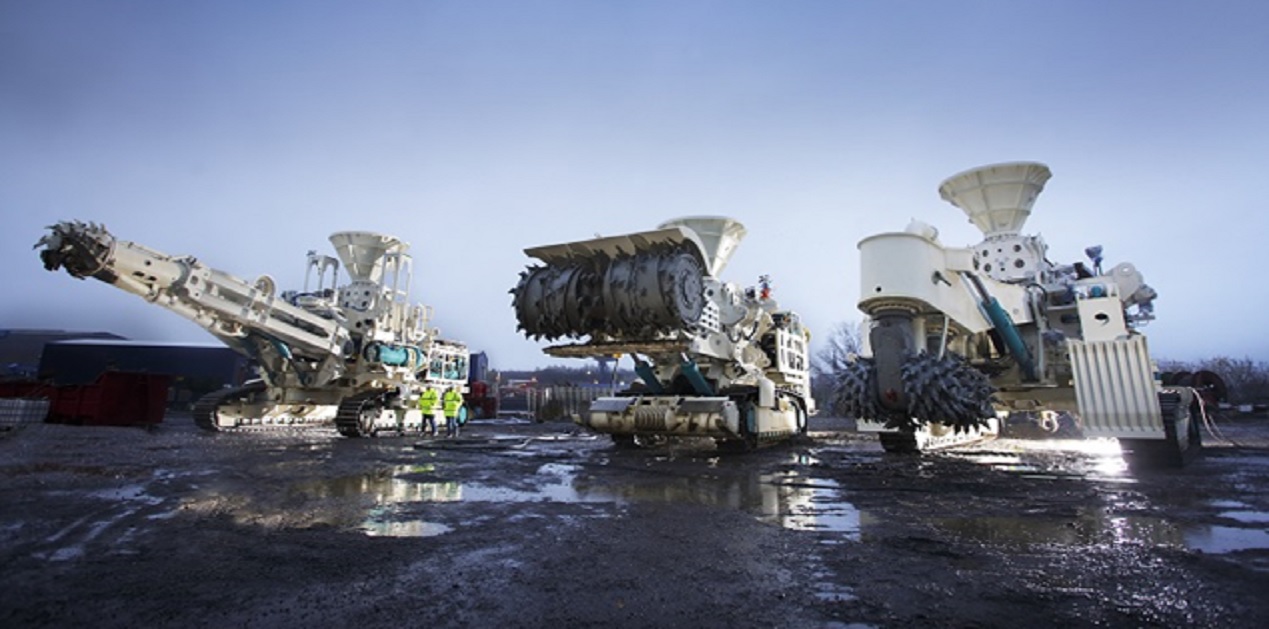Introduction
The global energy system is currently in the midst of a major transition to clean energy. However, the technologies underpinning this clean energy transition such as hybrid/electric car batteries, solar panels and wind turbines require far more critical minerals such as cobalt, copper, lithium, nickel, rare earth elements, etc. than fossil fuel-based energy systems. While some of these minerals are available on land, environmental concerns, declining quality of ore, dwindling reserves, geopolitics, etc. has led to a growing interest in extracting them from the deep-sea. This article is the first in a two-part series on deep-sea mining. It argues that deep-sea mining now appears both inevitable and vital. However, the rush to extract critical minerals from the deep-sea could irreparably damage marine ecosystems and biodiversity. As such, it should be carried out with great caution and only after the potential risks to marine ecosystems and biodiversity are fully assessed, the technology is perfected, and strict regulatory frameworks are fully in place. Else, it could defeat the purpose of deep-sea mining which is to help the world transition towards a cleaner, greener, and more sustainable future.
Critical Minerals - Building Blocks for Clean Energy System
Critical minerals are “materials critical to industries that are also import-dependent on them, and to new technologies which often have no viable substitutes and whose supply, besides being constrained by limited recycling rates and options, is also dominated by one or a few suppliers.”[1] Economic importance and supply risks are major factors that determine a mineral’s criticality. Minerals deemed to be critical are generally associated with high-growth economic sectors, high-tech ones in particular, such as electronics, aerospace, defence, etc. The clean energy sector has also emerged as a major high-growth economic sector in recent years. As such, it has become the primary driver for the increased demand for some types of critical minerals. Clean energy technologies such as hybrid/electric car batteries, solar panels and wind turbines are highly material intensive, more so than fossil-fuel-based energy supply systems. The International energy Agency (IEA) observed in a 2021 report that “a typical electric car requires six times the mineral inputs of a conventional car, and an onshore wind plant requires nine times more mineral resources than a gas-fired power plant.”[2] And according to one expert, a single 75 kilowatt (kW) electric vehicle battery requires 56 kilogram of nickel, 7 kilogram each of manganese and cobalt, and 85 kilogram of copper for the vehicle’s wiring.[3] Besides, motors made from rare earth elements such as neodymium are used by both electric vehicles and wind turbines.
The ongoing shift to a clean energy system has already led to a huge increase in the requirements for critical minerals. For example, electric vehicles are now very close to the “tipping point” of rapid mass adoption due primarily to declining costs of batteries.[4] The tipping point has already been passed in countries like Norway where electric cars accounted for 54% of all cars sold in the country in 2020.[5] Experts have projected that 145 million electric vehicles of all types (except two/three-wheelers) could be on the roads by 2030, accounting for 7% of the road vehicle fleet.[6] Similarly, the deployment of solar power and wind power continues to accelerate in many countries and they will become the dominant source of electricity in the next few decades. In fact, wind and solar are the fastest growing sources of clean electricity and they generated, for the first time, 10% of electricity globally in 2021, double the level in 2015.[7] In all, 50 countries have now generated 10% of their electricity from wind and solar. Thus, the ongoing energy transition aimed at limiting global warming to a tolerable 1.5°C or even 2°C by 2100 will lead to an exponential increase in demand for critical minerals to manufacture clean energy technologies. As such, production of these minerals is projected to increase by nearly 500% by 2050.[8]
The Deep-sea: A New Frontier for Mining Critical Minerals
While there are still abundant reserves of critical minerals on land, mining them has become increasingly problematic and unsustainable. Declining quality of ore, rising energy costs, rising environmental costs, chronic socio-political instability in key countries like the Democratic Republic of Congo (DRC), China’s monopolization and weaponization of rare earth elements, etc. has raised questions about the sustainability of depending on critical minerals that are mined on land. As a result, deep-sea mining or the retrieving of mineral deposits from the seabed is increasingly seen as an attractive alternative to mining on land.
The deep-sea refers to the portion of the world’s ocean that are greater than 200 meters in depth and they typically lies beyond national jurisdiction i.e. beyond a country’s Exclusive Economic Zone (EEZ). It encompasses 90% of the ocean and 50% of the Earth’s surface. Its topography comprises of abyssal plain (underwater plain), submarine canyons (steep-sided valley of the continental slope), oceanic trenches (long, narrow underwater depressions) and ridges (long, narrow underwater mountain systems), hydrothermal vents (underwater fissure from which geo-thermally heated water discharges), and seamounts (underwater mountains). Concentrations of critical minerals in the deep-sea are believed to be much higher than on land and they occur in the form of manganese nodules or poly-metallic nodules, seafloor massive sulfides or poly-metallic sulfides, and cobalt-rich crusts. Poly-metallic nodules are rock concretions the size of golf balls to bowling balls. They contain manganese, nickel, copper, cobalt, molybdenum, rare earth elements, platinum, tellurium, etc. are found on the abyssal plain. Poly-metallic sulfides on the other hand are found on active and inactive hydrothermal vents. They contain sulfide, copper, gold, zinc, lead, barium, silver, etc. Lastly, cobalt-rich crusts containing cobalt, copper, iron, manganese, nickel, platinum, etc. are found on the flanks and summits of seamounts. These minerals are seen as the solution to climate change. One Canada-based mining company, The Metals Company, went as far as to describe poly-metallic nodules as “a battery in a rock” and “the cleanest path toward electric vehicles.”[9]

Commercial deep-sea mining has not yet begun anywhere in the world. The International Seabed Authority (ISA) that consisted of 167 Member States and the European Union (EU) is mandated under the United Nations Convention on the Law of the Sea (UNCLOS) to regulate and control all mineral-related activities in the deep-sea. ISA has been working on a set of rules called the Mining Code “to regulate prospecting, exploration and exploitation of marine minerals in the international seabed Area.”[10] Although the Mining Code was due to be finalized by July 2020, it got delayed by the COVID-19 pandemic and therefore it still remained a work in progress. As such, the 31 prospecting and exploration licenses that the ISA has already awarded to 22 contractors (national governments and state and private mining companies) remained just that, prospecting and exploration licenses and not exploitation or commercial mining licenses.[11] Nineteen of these licenses are awarded for the exploration of poly-metallic nodules in the Pacific Ocean and the Indian Ocean; seven contracts are for the exploration of poly-metallic sulfides in the Indian Ocean and the Atlantic Ocean; and five contracts are for the exploration of cobalt-rich crusts in the Pacific Ocean. In all, 1.5 million square kilometers of the ocean’s surface, an area equivalent to the size of Mongolia, has been set aside for prospecting and exploration by the ISA.

Growing Demands for Moratorium on Deep-sea Mining
There are indications that deep-sea mining could become a reality much sooner than anticipated. On 25 June 2021, Lionel Aingimea, President of the tiny Pacific island of Nauru, issued an ultimatum to the ISA. He called upon the organization “to complete the adoption of rules, regulations, and procedures [the Mining Code] required to facilitate the approval of plans of work for exploitation in the [deep-sea] area within two years.”[12] He also indicated that Nauru will go ahead and start deep-sea mining by June 2023 in the Clarion-Clipperton Zone in the North Pacific Ocean between Hawaii and Mexico. Nauru’s action has generated a lot of interest and it could potentially open the floodgate on deep-sea mining irrespective of whether there are regulations in place or otherwise. That worries a number of experts and countries. While there is no doubt that mining of minerals from the deep-sea would greatly enhance the clean energy transition, it could also have adverse impact on marine ecosystems and biodiversity. The deep-sea is the most extensive habitat on Earth and supports high biodiversity. To put it into perspective, the ocean has around 2.2 million species of which 90% still remains undescribed or named.[13] It is feared that many endemic deep-sea species could be wiped out by the creation of a single large mine and many other creatures will be affected by noise, light pollution and plumes of mining sediment.
Not surprisingly, growing number of experts and countries have called for a moratorium on deep-sea mining. More than 600 scientists from 44 countries have signed a petition in June this year. The petition declared that deep-sea mining would add to the number of “anthropogenic stressors” that included climate change, bottom trawling and pollution, and would result in the loss of biodiversity and ecosystem functioning that would be “irreversible on multi-generational timescales.”[14] As such, they called for a moratorium on deep-sea mining “until sufficient and robust scientific information has been obtained.”Several Pacific island countries such as Palau and Fiji have also launched an “alliance” of countries calling for a global moratorium on all deep-sea mining activities.[15] Speaking at the United Nations Ocean Conference that was held in Lisbon, Portugal in June 2022, President Surangel Whipps of Palau declared that deep-sea mining is “not worth the risk” as it will only increase the vulnerability of the sea floor and marine life. The G7 countries have also agreed that stringent environmental controls should govern deep-sea mining and that they would consent to such mining projects only if they did not seriously harm the marine environment.[16]
Conclusion
Climate change is considered an “existential threat” to humanity its impact is currently being felt with growing intensity and frequency.[17] Addressing it requires limiting the increase in average global temperature to the relative safe limits of 1.5°C or even 2°C by the end of 2100. This can only be achieved through accelerated global transition towards clean energy. But such energy transition will require substantially more critical minerals to manufacture clean energy technologies. While there are ample reserves of critical minerals on land to manufacture the necessary technologies, mining them have become increasingly costly –economically, environmentally and socially. And it is also fraught with geopolitical risks. In light of this, deep-sea mining have become a matter of necessity. But the required regulatory frameworks have not kept pace with the growing interest in deep-sea mining. Going forward, it is imperative that deep-sea mining be paused until sufficient and robust scientific information about the deep-sea has been obtained and strict regulatory frameworks are fully in place. At the same time, the capacity to recycle and re-use products should be increased so that there is less demand for extraction of critical minerals either on land or in the deep-sea. And new types of clean energy technologies that require far less critical minerals ought to be found and deployed.
End Notes :
[1]Umbach, Frank. 2020. “The New “Rare Metal Age”: New Challenges and Implications of Critical Raw Materials Supply Security in the 21st Century.” Working Paper No. 329. S. Rajaratnam School of International Studies (RSIS). Nanyang Technological University (NTU). Singapore. April 27.
https://www.rsis.edu.sg/wp-content/uploads/2020/04/WP329_V2.pdf
[2]International Energy Agency (IEA). 2022. “The Role of Critical World Energy Outlook Special Report Minerals in Clean Energy Transitions.” World Energy Outlook Special Report. Paris.
https://iea.blob.core.windows.net/assets/ffd2a83b-8c30-4e9d-980a-52b6d9a86fdc/TheRoleofCriticalMineralsinCleanEnergyTransitions.pdf
[3]Hylton, Wil S. 2020. “History’s largest mining is about to begin.” The Atlantic. January/February Issue.
https://www.theatlantic.com/magazine/archive/2020/01/20000-feet-under-the-sea/603040/
[4]Carrington, Damian. “Electric vehicles close to ‘tipping point’ of mass adoption.” The Guardian. January 22, 2021.
https://www.theguardian.com/environment/2021/jan/22/electric-vehicles-close-to-tipping-point-of-mass-adoption
[5] “Electric cars rise to record 54% market share in Norway.” The Guardian. January 5, 2021.
https://www.theguardian.com/environment/2021/jan/05/electric-cars-record-market-share-norway
[6]International Energy Agency (IEA). 2021. “Global EV Outlook 2021: Accelerating ambitions despite the pandemic.” Paris. April.
https://iea.blob.core.windows.net/assets/ed5f4484-f556-4110-8c5c-4ede8bcba637/GlobalEVOutlook2021.pdf
[7]Ember. 2022. “Global Electricity Review 2022.” March.
https://ember-climate.org/app/uploads/2022/03/Report-GER22.pdf
[8]Hund, Kirsten, Daniele La Porta, Thao P. Fabregas, Tim Laing and John Drexhage. 2020. “Minerals for Climate Action: The Mineral Intensity of the Clean Energy Transition.” International Bank for Reconstruction and Development/The World Bank. Washington, D.C.
https://pubdocs.worldbank.org/en/961711588875536384/Minerals-for-Climate-Action-The-Mineral-Intensity-of-the-Clean-Energy-Transition.pdf
[9]Baker, Aryn. “A Climate Solution Lies Deep Under the Ocean—But Accessing It Could Have Huge Environmental Costs.” TIME. September 10, 2021.
https://time.com/6094560/deep-sea-mining-environmental-costs-benefits/
[10]International Seabed Authority (ISA). 2022. “The Mining Code.”
https://www.isa.org.jm/mining-code
[11]International Seabed Authority (ISA). 2022. “Exploration Contracts.”
https://isa.org.jm/exploration-contracts
[12]Lyons, Kate. “Deep-sea mining could start in two years after Pacific nation of Nauru gives UN ultimatum.” The Guardian. June 30, 2021.
https://www.theguardian.com/world/2021/jun/30/deep-sea-mining-could-start-in-two-years-after-pacific-nation-of-nauru-gives-un-ultimatum
[13]Paulus, Eva. 2021. “Shedding Light on Deep-Sea Biodiversity-A Highly Vulnerable Habitat in the Face of Anthropogenic Change.” Frontiers in Marine Science. April 6. https://www.frontiersin.org/articles/10.3389/fmars.2021.667048/full
[14] “Marine Expert Statement Calling for a Pause to Deep-Sea Mining.”
https://www.seabedminingsciencestatement.org/
[15] “Not worth the risk': Palau, Fiji call for deep-sea mining moratorium.” Reuters. June 28, 2022.
https://www.reuters.com/business/environment/not-worth-risk-palau-fiji-call-deep-sea-mining-moratorium-2022-06-27/
[16] “G7 countries say strict environmental rules needed for deep-sea mining.” Reuters. May 28, 2022.
https://www.reuters.com/world/g7-countries-say-strict-environmental-rules-needed-deep-sea-mining-2022-05-27/
[17] “Climate change: An ‘existential threat’ to humanity, UN chief warns global summit.” UN News. May 15, 2018. https://news.un.org/en/story/2018/05/1009782
(The paper is the author’s individual scholastic articulation. The author certifies that the article/paper is original in content, unpublished and it has not been submitted for publication/web upload elsewhere, and that the facts and figures quoted are duly referenced, as needed, and are believed to be correct). (The paper does not necessarily represent the organisational stance... More >>
Image Source: http://dsmf.im/gallery/











Post new comment